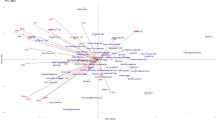Abstract
The pigeonpea core collection developed at ICRISAT genebank consists of 1,290 accessions from 53 countries. The core collection, which includes selected lines in extra early, early, medium and late maturity groups was evaluated for 18 qualitative and 16 quantitative characters during the 2004 rainy season, to assess the phenotypic diversity and determine the relative importance of different characters in evaluating pigeonpea germplasm accessions. The four maturity groups differed significantly for all characters under study. The medium maturity group showed significantly higher mean number of primary, secondary and tertiary branches, number of racemes, pod bearing length, pods per plant, shelling percent and plot seed yield. Late maturity group showed significantly higher mean for leaf size, plant height, pod length, seeds per pod and 100-seed weight, indicating this group as a good source of vegetable pigeonpea. Significant positive correlations were found between number of secondary branches and pods per plant in extra early group (r = 0.756), late maturity group (r = 0.776) and entire core (r = 0.728) and between number of racemes and pods per plant in all maturity groups and entire core. Principal coordinate and principal component analysis showed that seven qualitative and nine quantitative traits were important in explaining multivariate polymorphism. The Shannon–Weaver diversity index (H′) varied for different maturity groups and traits. Phenotypic diversity, averaged over all the 16 characters, increases from extra early group (0.36 ± 0.04) to late maturity group (0.42 ± 0.04) suggesting that medium and late maturity groups have greater diversity compared to extra early and early maturity groups.
Similar content being viewed by others
References
Bhatia GK, Gupta SC, Green JM, Sharma D (1981) Estimates of natural cross-pollination in Cajanus cajan (L.) Millsp.: several experimental approaches. In: ICRISAT, Proc. Int. Workshop pigeonpeas, Patancheru, A.P. India, 15–19 Dec 1980, vol 2, pp 129–136
Brown AHD (1989) Core collections: a practical approach to genetic resources management. Genome 31: 818–824
Food and Agriculture Organization (2004) http://www.FAO.ORG/FAOSTAT database
Food and Agriculture Organization (2005) http://www.FAO.ORG/FAOSTAT database
Frankel OH (1984) Genetic perspectives of germplasm conservation. In: Arber WK, Llimensee K, Peacock WJ, Starlinger P (eds) Genetic manipulation: Impact on Man and Society. Cambridge University Press, Cambridge, pp 161–170
Frankel OH, Soule ME (1981) Conservation and evolution. Cambridge University Press, New York
IBPGR and ICRISAT (1993) Descriptors for Pigeonpea [Cajanus cajan (L.) Millsp.]. International Board for plant Genetic Resources, Rome, Italy. International Crops Reseasrch Institute for the Semi-Arid Tropics, Patancheru, India
ICRISAT (International Crops Research Institute for the Semi-Arid Tropics) (1978) Annual Report 1977/78. Patancheru, A.P. 502 324, India, ICRISAT 295 pp
Johns MA, Skroch PW, Nienhuis J, Hinrichsen P, Bascur G, Munoz-Schick C (1997) Gene pool classification of common bean landraces from Chile based on RAPD and morphological data. Crop Sci 37:605–613
Keuls M (1952) The use of the “Studentized range” in connection with an analysis of variance. Euphytica 1:112–122
Laxman Singh, Gupta SC, Faris DG (1990) Pigeonpea: Breeding. In: Nene YL, Hall SD, Sheila VK (eds) The Pigeonpea. C.A.B. International, Wallingford, OXM OX10 8DE, UK, pp 1–14
Levene H (1960) Robust tests for equality of variances. In: Oklin I (eds) Contributions to probability and statistics. Essays in honour of Harold Hotelling. Stanford University Press, Stanford, pp 278–292
Nene YL, Sheila VK (1990) Pigeonpea: Geography and importance. In: Nene YL, Hall SD, Sheila VK (eds) The Pigeonpea. C.A.B. International, Wallingford, OXM OX10 8DE, UK, pp 1–14
Newman D (1939) The distribution of range in samples from a normal population expressed in terms of an independent estimate of standard deviation. Biometrika 31:20–30
Pathak GN (1970) Red gram. In: Pulse crops of India. Indian Council of Agricultural Research, New Delhi, India, pp 14–53
Reddy LJ, Chandra S, Pooni H, Bramel PJ (2004) Rate of outcrossing in pigeonpea under intercropped conditions. In: Bramel PJ (eds) Assessing the risk of losses in biodiversity in traditional cropping systems: a case study of Pigeonpea in Andhra Pradesh. International Crops Research Institute for the Semi-Arid Tropics. Patancheru 502 324, Andhra Pradesh, India. 168 pp
Reddy LJ, Upadhyaya HD, Gowda CLL, Sube Singh (2005) Development of core collection in pigeonpea [Cajanus cajan (L.) Millsp.] using geographic and qualitative morphological descriptors. Genetic Resour Crop Evol 52:1049–1056
Remanandan P, Sastry DVSSR, Mengesha MH (1988) ICRISAT pigeonpea germplasm catalog: evaluation and analysis. Patancheru, A.P. 502324, India; International Crops Reseasrch Institute for the Semi-Arid Tropics
Saxena KB, Laxman Singh, Gupta MD (1990) Variation for natural out-crossing in pigeonpea. Euphytica 46:143–148
Saxena KB, Sharma D (1990) Pigeonpea: Genetics. In: Nene YL, Hall SD, Shiela VK (eds) The pigeonpea. C.A.B. International, Wallingford, Oxon OX 10 8DE, UK, pp 44–87
Shannon CE, Weaver W (1949) The mathematical theory of communication. University of Illinois Press, Urbana
Skinner DZ, Bauchan GR, Auricht G, Hughes S (1999) A method for the efficient management and utilization of large germplasm collections. Crop Sci 39:1237–1242
Snedecor GW, Cochran WG (1980) Statistical methods, 7 edn. Iowa State University Press, Ames
Upadhyaya HD, Ortiz R (2001) A mini core subset for capturing diversity and promoting utilization of chickpea genetic resources in crop improvement. Theor Appl Genet 102:1292–1298
Upadhyaya HD, Pundir RPS, Gowda CLL, Reddy KN, Sube Singh (2005). Geographical patterns of diversity for qualitative and quantitative traits in the pigeonpea germplasm collection. Plant Genetic Resour 3(3):331–352
van der Maesen LJG (1980) India is the native home of pigeonpea Miscellaneous Papers 19 (1980) Landbouwhogeschool, Wageningen
Author information
Authors and Affiliations
Corresponding author
Rights and permissions
About this article
Cite this article
Upadhyaya, H.D., Reddy, K.N., Gowda, C.L.L. et al. Phenotypic diversity in the pigeonpea (Cajanus cajan) core collection. Genet Resour Crop Evol 54, 1167–1184 (2007). https://doi.org/10.1007/s10722-006-9008-5
Received:
Accepted:
Published:
Issue Date:
DOI: https://doi.org/10.1007/s10722-006-9008-5




